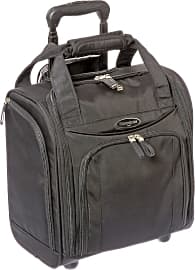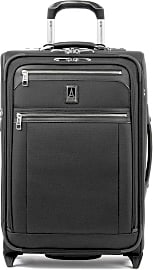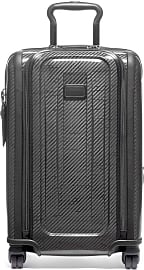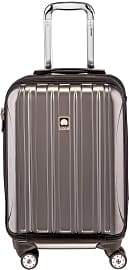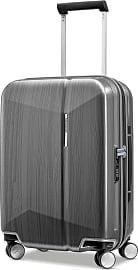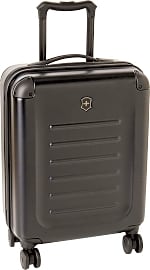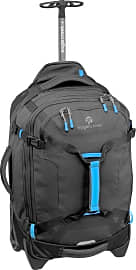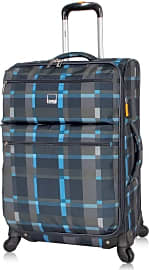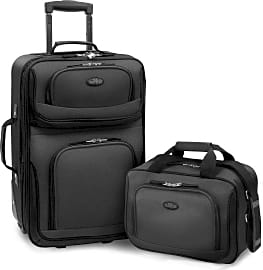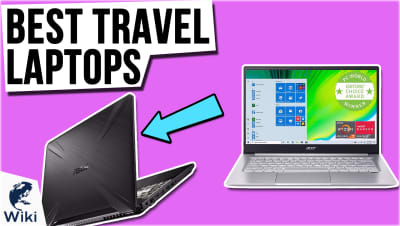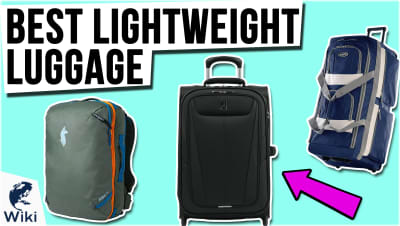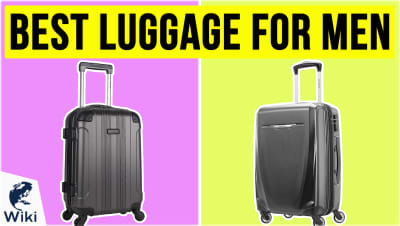The 10 Best Carry On Luggage

This wiki has been updated 39 times since it was first published in February of 2015. Now that most airlines charge an arm and a leg to check bags, your best option is to get everything into your carry-on luggage. This will allow you to save a small fortune that can be put to better use having fun at your destination, like a fancy dinner or tour. Our selection includes models ideal for everyone from professional road warriors to casual weekend wanderers. When users buy our independently chosen editorial selections, we may earn commissions to help fund the Wiki.
Editor's Notes
March 03, 2021:
When you pick a good piece of luggage, it will last through years of use and countless trips, which is exactly why we didn't need to make a lot of changes to our recommendations. The selections here represent some of the best names in the business in a variety of price ranges.
In fact, the only notable replacement we made was to swap out the Tumi Tegra Lite Max Continental for the Tumi Tegra Lite 2 International. We like the latter better thanks to its hidden USB port, because we know that all travelers have run into situations where their phone runs low on battery power right when they need it to book an Uber or get directions to their hotel. This one, along with the Delsey Helium Aero, is ideal for people who travel with a laptop and want to be able to access their device quickly when passing through security.
Heavy packers should probably turn to the Briggs & Riley Baseline because of its compression system that packs everything down for you, so you won't be left struggling and putting all your weight on your luggage just to get it to zip closed. The Lucas Ultra is another good option for those who like to bring a lot of stuff along on their travels, as its expansion zipper adds an addition four liters to its already high capacity.
If you like the idea of a duffle, but want the convenience to roll your luggage at times, turn to the Eagle Creek Load Warrior, which offers the best of both worlds.
May 21, 2019:
The right carry on luggage can make or break a trip, especially if you often bounce from place to place. These days, you can find a range of handy features that make an already convenient item even more so. For example, the Briggs & Riley Baseline has an expansion-compression system that allows you to overstuff it, then reduce its size, so you always meet airline regulations. The Victorinox Spectra 2.0 has a removable laptop sleeve that makes going through security less of a hassle, and the Samsonite Etude features a removable toiletry bag that makes for quicker unpacking when you reach your destination. The Travelpro Platinum Elite and Samsonite Underseater also have this handy feature. For business travelers, or anybody else concerned about having wrinkled clothes when they arrive, we recommend the Briggs & Riley Baseline, Travelpro Platinum Elite, Tumi Tegra Lite Max, which are all equipped with suiters. We realize that the price of the Briggs & Riley Baseline and Tumi Tegra Lite Max may seem exorbitant to some, and in truth they generally aren't worth it for anybody who doesn't travel often, there is some credence to the saying that you get what you pay for. It is not uncommon for models from these companies these to still be in great shape after 10 years of constant use, when lesser brands would have long since failed in some manner.
Special Honors
Away The Carry On The sleek Away The Carry On comes in a wide range of colors, as well as several two-tone options for those who really like to stand out. It is also available with or without a battery and USB port for charging your devices. awaytravel.com
Monos Carry On Pro If you travel with a laptop, you'll appreciate the easy-access front compartment on the Monos Carry On Pro that makes it a cinch to quickly remove your computer when passing through security. It is crafted from a tough aerospace-grade polycarbonate that keeps all of its contents well protected, and it even comes with a 100-day trial period, in which you can return it for full money back if you don't like it. monos.com
Choosing the Right Carry On Bag
These bags are best for those who want flexibility and aren't prone to overstuffing their suitcases.
Get out your tape measure: most U.S. airlines allow carry on bags no larger than 22" x 14" x 9". Some domestic airlines allow slightly taller bags, so research the size restrictions for your preferred airline. The carry on size restrictions for international travel are usually a little smaller. Use this chart to find the size restrictions for a given airline.
When choosing your bag, check that its dimensions include the wheels, handles, and exterior pockets, which will all need fit within the airline's size allowance. Some suitcases offer an expansion feature that provides a little more room and flexibility. Also consider the handle placement: if the telescoping handle is located on the exterior of the bag, it will take up more of the allowed dimensions, but offers a nice, flat surface inside the bag that helps prevent wrinkles. When the handle is embedded into the suitcase frame, it protrudes into the main compartment, but this uneven surface can be made level by stuffing socks and underwear into the bottom of the bag.
Wheels: Spinners and Rollers
Spinners have four pivoting wheels that grant 360 degrees of mobility and make maneuvering your luggage through crowded airports easy. They roll upright, which puts less weight on the arm and removes strain from the shoulder and elbow. Spinner wheels are usually located on the exterior of the suitcase, however, which makes them more prone to breakage, so make sure that your spinner wheels are attached with screws rather than rivets — they'll be more secure and easier to replace. Spinner bags are not recommended for use on rough surfaces like cobblestone roads.
Rollers have two wheels and must be tipped at an angle to roll. In rollers, the wheels are usually recessed, making them less vulnerable to damage but leaving less space for clothing. While they do put more weight on the arm, they're better for those who often find themselves running between terminals because they are pulled rather than pushed, as is the case with spinners. If you do opt for a roller bag, make sure the wheels are set far apart; if they're too close together, it will be easy to lose control of the bag.
Materials: Hard or Soft?
These days, hard-sided luggage is usually made out of super lightweight polycarbonate. These bags offer protection if you're traveling with fragile items and are typically very durable. Hard-sided bags rarely feature any exterior pockets, which some people prefer as it allows them to make the most of the interior space, but others dislike the lack of built-in organization.
Soft-sided bags, typically made from ballistic nylon or other synthetic fabrics, offer greater versatility. They are available with all sorts of pocket configurations and in different styles, such as the backpack or duffle wheelie. Soft-sided bags can also better absorb impact, and unlike hard-sided bags, they can be squeezed into overhead compartments. That said, clothes are more likely to become wrinkled inside soft bags. These bags are best for those who want flexibility and aren't prone to overstuffing their suitcases.
Organization
Pockets are perhaps the most dependent on individual preference, so consider how you want to use them. Some bags, for instance, offer padded exterior pockets that hold laptops and tablets. Exterior pockets can also be useful for storing toiletries and liquids, where they're separate from garments and easily accessible during airport security. Be wary of overfilling exterior compartments — if they become too heavy, the bag may tip over. Interior pockets can be used for anything ranging from dirty laundry to shoes — it depends on the bag. Some suitcases offer garment suiters, which are trifold compartments designed to keep dress clothes from wrinkling.
Advantages of Taking a Carry On Bag
Although checked bags offer more space, there are plenty of good reasons to bring a carry on for your next flight.
Foremost, many domestic airlines allow each passenger to bring one carry on bag for free. However, there are often charges for checked bags for domestic flights, depending on the airline. That said, if your carry on doesn't fit in the metal basket that airlines use to check size, they could make you pay a fee to gate check your bag.
If a flight is full, some airlines will offer to gate check carry on bags for free, offering those who do check their bags priority boarding.
If a flight is full, some airlines will offer to gate check carry on bags for free, offering those who do check their bags priority boarding. Take airlines up on this offer — although you will have to wait for your bag at the luggage carousel, it's a great way to bring a carry on without dealing with the hassle of fitting it into the overhead bins.
If you don't gate check your bag, using a carry on lets you avoid the long waits for baggage following the flight. Carry ons also offer constant access to your belongings and valuables while at the airport and on the plane, as well as the reassurance that the airline won't lose your bag. There are also time benefits: checking in to your flight goes more smoothly when you don't have to check a bag.
To make traveling with your carry on go smoothly, ensure that it is light enough for you to lift into the overhead bins — there won't always be a helpful stranger nearby. Use an overhead bin as close to your seat as possible, which makes de-boarding easier. Also make sure you can close the overhead bin with your bag inside, because if it doesn't close, flight attendants may have to store it elsewhere (and you don't want to be that guy, do you?)
The Origins of Modern Luggage
The earliest forms of luggage date back to ancient wheeled weaponry carts used in Palestine during the Crusades, which were designed to move weapons and equipment for the Knights Templar. There was also luggage used during the Roman Empire, as evidenced by the luggage tag discovered in the Chester fortress, marking the property of Julius Candidus. (I guess even the ancient Romans mixed up their luggage.)
In the Middle Ages, wealthy aristocrats traveled with canvas- or leather-covered wooden chests, whose interiors were compartmentalized. Chests like these, in addition to portmanteaus and Gladstone bags, were the dominant form of luggage up through the mid-19th century.
Louis Vuitton, a trunk maker, achieved renown for his slat trunks that had stackable, flat tops in contrast to the rounded tops that were popular at the time.
The English word luggage emerged at the end of the 16th century, according to the Oxford English dictionary. It was derived from the verb lug, meaning to literally drag about.
The first patent for wheeled luggage emerged during the Company Raj in 1848, when the Maharani of Nadir came to an official reception atop an elephant-drawn wheeled trunk. A British colonel who saw the trunk applied for a patent in London, but the application was supposedly lost. Coincidentally, a month later Queen Victoria awarded her husband Prince Albert a patent and three gold medals for his uncannily similar invention, the "Travelling Carry-All, Omni-Conveyance, Bewheeled.”
The 1800s also saw the rise of pinewood steamer trunks, designed for rough overseas travel on steamer ships. Featuring sturdy iron bases, these trunks were covered in canvas or tree sap to protect against water damage. Louis Vuitton, a trunk maker, achieved renown for his slat trunks that had stackable, flat tops in contrast to the rounded tops that were popular at the time.
As travel for leisure became increasingly accessible during the 20th century, luggage became a profitable venture for manufacturers. Companies such as Samsonite and American Tourist began creating suitcases — originally literally designed to hold suits — as air travel in the 1930s became more popular than travel by trains and ships. The first lightweight aluminum suitcase was made available in 1950 by the German company Rimowa.
Still, wheeled luggage had yet to exist. In 1958 an American businessman named D. Dudley Bloom proposed wheeled luggage, but he was mocked and rejected by executives at Atlantic Products Corporation. It wasn't until Bernard Sadow patented a wheeled suitcase in 1972 that the market finally accepted wheeled luggage, with the addition of the telescoping handle coming roughly a decade later.


